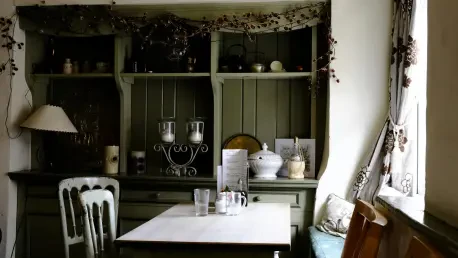In bustling urban centers, where skyscrapers tower and living spaces shrink, a pressing question emerges: could the addition of an extra bedroom in an apartment be the nudge young couples need to start a family, especially when cramped one-bedroom units dominate the rental market? Across major cities, these small spaces often leave little room—literally and figuratively—for thoughts of children. As housing costs continue to climb, the notion that apartment design might influence birth rates is no longer just a curiosity but a critical issue for policymakers, developers, and families alike. This exploration delves into whether more rooms could mean more babies, unpacking the intricate ties between space and societal trends.
Unpacking the Space-Baby Connection
The idea that physical space shapes life decisions isn’t new, but its implications for family planning are gaining attention. In densely populated urban areas, young couples often squeeze into small apartments, prioritizing proximity to jobs over room for growth. The question arises: does the lack of an extra bedroom deter the decision to have a child, or is it merely one piece of a larger puzzle? Housing experts and demographers are increasingly examining how the built environment intersects with deeply personal choices, suggesting that design might play a more pivotal role than previously thought.
Beyond just square footage, the psychological impact of space cannot be overlooked. A cramped apartment can feel like a temporary stop, not a place to build a future. When walls close in, the dream of parenthood might feel out of reach, delayed by the practicalities of where a crib could even fit. This dynamic sets the stage for a broader debate on whether adjusting apartment layouts could address declining fertility rates, a concern for many developed nations facing aging populations.
Why Housing Design Matters for Family Formation
Housing design extends far beyond aesthetics; it’s a factor in shaping demographic trends. In the United States, where fertility rates have dipped below replacement levels, the availability of family-friendly apartments is under scrutiny. Research from prominent family-focused organizations indicates that many couples postpone having children due to inadequate living spaces, unable to find affordable units with multiple bedrooms in urban hubs. This delay isn’t just personal—it ripples through society, affecting everything from school enrollments to economic growth.
Economic pressures compound the issue, as soaring rents force tough trade-offs. For many, the choice between a larger apartment in a distant suburb or a tiny unit near work isn’t just about convenience but about the feasibility of family life. Cultural norms also play a role, with lingering expectations of homeownership as the ideal backdrop for raising kids, often sidelining apartments as viable long-term homes. These intertwined factors highlight that housing isn’t merely a roof over one’s head but a foundation for life’s biggest decisions.
The Debate: More Rooms Versus Smarter Spaces
Opinions split sharply on how to tackle the housing-fertility link through design. Advocates for larger apartments argue that adding two- or three-bedroom units directly addresses family needs, creating both physical space and a mindset conducive to growth. Survey data from recent studies in major cities reveal high demand for such units, with low vacancy rates signaling an undersupply. Proponents believe that more rooms signal stability, encouraging couples to take the leap into parenthood sooner rather than later.
Conversely, another school of thought prioritizes efficiency over sheer room count. Critics argue that smaller, well-designed units in dense, walkable neighborhoods can meet family needs at lower costs by maximizing every inch of space. They point to the value of community amenities—parks, libraries, and shared spaces—as extensions of home, reducing the need for sprawling personal areas. This perspective also notes the post-pandemic shift, where remote work has pulled some toward larger, suburban spaces, complicating urban density goals.
The tension between these views underscores a broader challenge: balancing housing policy with demographic aims. While more rooms might appeal to some, affordability remains key for most renters. The debate reveals that no single solution fits all, as lifestyle preferences and economic realities vary widely across regions and generations, leaving planners and builders at a crossroads.
Voices from the Field: Data and Personal Stories
Hard numbers paint a compelling picture of the demand for family-oriented housing. Recent surveys show a marked preference for multi-bedroom apartments, with vacancy rates for such units significantly lower than for studios or one-bedrooms in urban markets. Reports from housing lenders also highlight a generational shift, noting that younger renters value the flexibility of leasing over the burden of owning, suggesting apartments could become long-term family hubs if designed thoughtfully.
Personal accounts add a human layer to these statistics. A couple in a major city shared how they postponed starting a family, waiting years to upgrade from a one-bedroom rental to a space where a nursery felt feasible. Their story resonates with countless others in high-cost areas, where the dream of parenthood often hinges on finding the right home. These narratives underscore the emotional weight of housing constraints, showing how deeply personal milestones are tied to brick-and-mortar realities.
Expert insights further enrich the conversation, with urban planners emphasizing that design alone isn’t enough without addressing affordability. One housing analyst noted, “You can build all the three-bedroom units you want, but if rents are out of reach, they won’t solve the family formation puzzle.” This blend of data, lived experience, and professional opinion illustrates the multifaceted nature of the issue, bridging abstract policy with tangible human impact.
Practical Solutions for Family-Friendly Housing
Turning theory into action requires innovative approaches to apartment design and policy. One starting point is revising zoning laws to permit more multi-bedroom units in city centers, striking a balance between density and family needs. Developers could adopt modular layouts, creating flexible spaces that adapt as families grow—think walls that move or rooms that double as offices and nurseries. Such designs maximize utility without inflating costs, offering a middle ground for builders and renters alike.
On the policy front, incentives like tax breaks or subsidies for family-friendly construction could spur change, provided they prioritize affordability. For renters, seeking out neighborhoods with high walkability scores offers another path, where public spaces like parks become natural extensions of smaller homes. These areas reduce the pressure for expansive personal square footage, allowing couples to focus on community rather than confinement.
Collaboration among stakeholders is key to making these ideas a reality. Governments, developers, and community advocates must align on shared goals, ensuring that housing solutions don’t just add rooms but create environments where families can thrive. By blending practical design tweaks with strategic urban planning, the gap between current constraints and demographic aspirations can begin to narrow, paving the way for meaningful progress.
Reflecting on this exploration, it becomes clear that the conversation around apartment design and birth rates has evolved into a catalyst for broader change. Stakeholders have started to recognize that housing isn’t just about shelter but about shaping futures. Moving forward, the focus shifts toward actionable steps: revising outdated zoning, incentivizing smart design, and prioritizing walkable communities. These efforts promise to address not only space but also the deeper economic and cultural barriers to family formation. As cities continue to grow, the challenge remains to build homes that don’t just house bodies but nurture dreams, ensuring that every extra room could indeed mean a new beginning.









